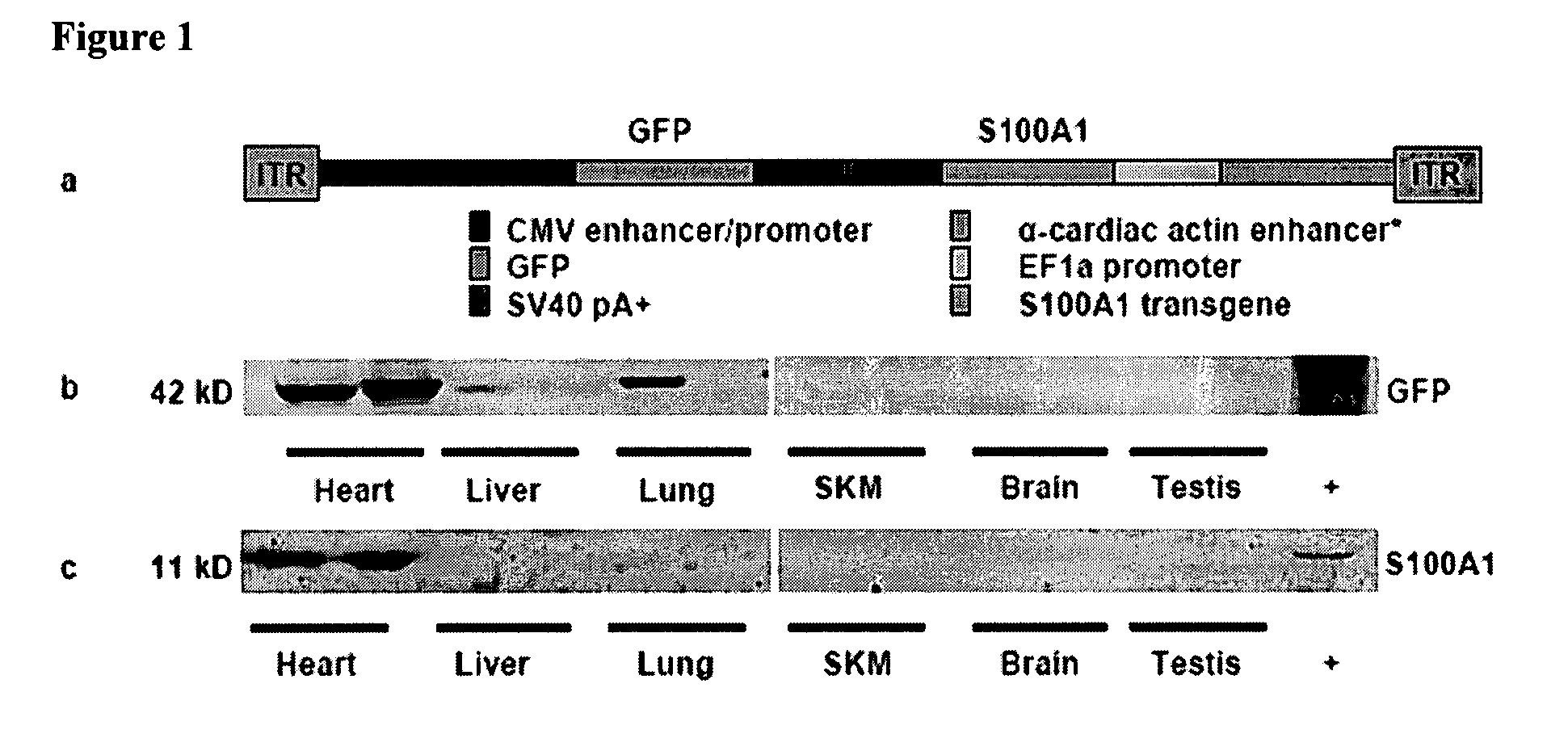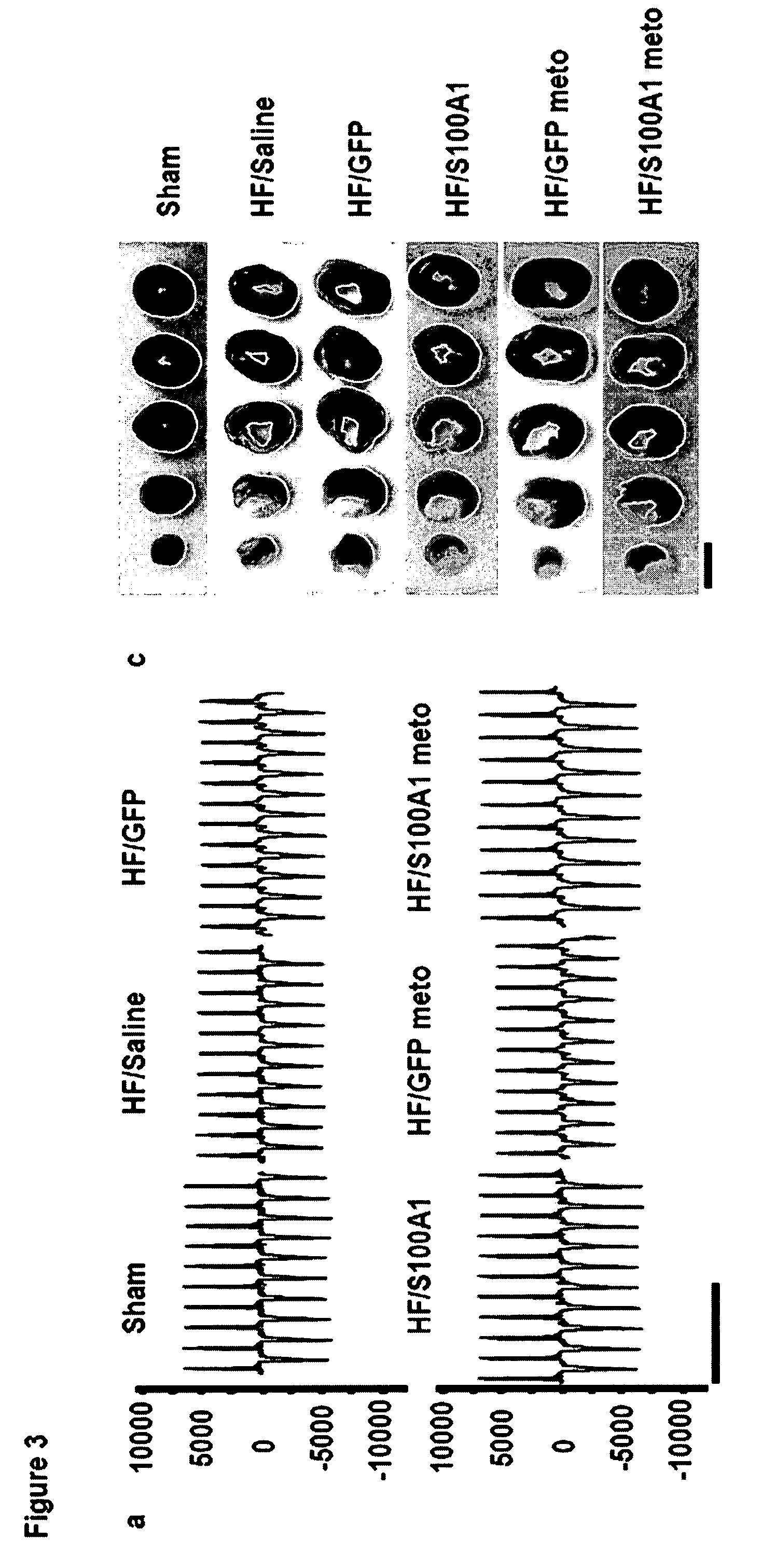Tissue specific gene therapy treatment
a gene therapy and tissue technology, applied in the direction of genetic material ingredients, cardiovascular disorders, drug compositions, etc., can solve the problems of unsatisfactory existing treatments and enormous clinical challenges of chronic heart failure, and achieve the effect of reducing the risk of heart failur
- Summary
- Abstract
- Description
- Claims
- Application Information
AI Technical Summary
Benefits of technology
Problems solved by technology
Method used
Image
Examples
example 1
[0101]Chronic in vivo S100A1 expression in myocardial cells
[0102]Experimental Procedures
[0103]Construction of α-cardiac actin enhancer-EF1α promoter—Genomic DNA was isolated from mouse (C57 / BL6) muscle and PCR amplification was performed using PfuUltra (Stratagene) with the following primer pair; forward 5′-AGGAATTCTAAATTTACGTCTGCTTCCTGTCAATGGGC-3′ (SEQ. ID. No. 9) and reverse 5′-CCAGACTAGTCAGCTGCTTTTCAGTTCACACCAG-3′ (SEQ. ID. No. 10). This resulted in a 324 base pair fragment containing the α-cardiac actin MEF2 domain22. The fragment contained an extra MEF2 element built into the forward primer and two enhancer MyoD consensus sequences. This fragment was cloned in place of the CMV enhancer sequence in pCpGLacZ (Invivogen), resulting in pCpGα-cardLacZ. The human S100A1 gene was cloned by PCR using PfuUltra (Stratagene) using the following primer pair; forward 5′-CTGCCATGGGCTCTGAGCTGGAGACGGCG-3′ (SEQ. ID. No. 11) and reverse 5′-CCAGCTAGCTCATTCAACTGTTCTCCCCAGAAGAAATT-3′ (SEQ. ID. No. ...
example 2
[0144]S100A1 Expression in Endothelial Cells
[0145]Experimental Procedures
[0146]SKO mice—Mice with a deletion of the S100A1 gene (SKO) have been backcrossed into a C57BL / 6 background and characterized as described previously.11 SKO and wild-type (WT) mice of either sex and 3 months of age were used for this study. All animal procedures and experiments were performed in accordance with the guidelines of the IACUC of Thomas Jefferson University.
[0147]Isolation of mouse aortic endothelial cells—Mouse aortic endothelial cells (MAEC) from WT and SKO were obtained by outgrowth from aortic patches on a collagen matrix (Sigma) for three days in basal EBM-2 media (Cambrex, Walkersville, Md.) supplemented with vascular endothelial growth factor (VEGF) and 5% FCS as described previously.50 MAEC were identified morphologically and phenotyped by functional uptake of acetylated LDL and immunohistochemistry against vWF. Outgrowth resulted in a mixture of cell types and proportion of EC as measured ...
PUM
| Property | Measurement | Unit |
|---|---|---|
| molecular weight | aaaaa | aaaaa |
| MW | aaaaa | aaaaa |
| diameter | aaaaa | aaaaa |
Abstract
Description
Claims
Application Information
 Login to View More
Login to View More - R&D
- Intellectual Property
- Life Sciences
- Materials
- Tech Scout
- Unparalleled Data Quality
- Higher Quality Content
- 60% Fewer Hallucinations
Browse by: Latest US Patents, China's latest patents, Technical Efficacy Thesaurus, Application Domain, Technology Topic, Popular Technical Reports.
© 2025 PatSnap. All rights reserved.Legal|Privacy policy|Modern Slavery Act Transparency Statement|Sitemap|About US| Contact US: help@patsnap.com



